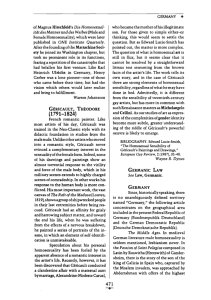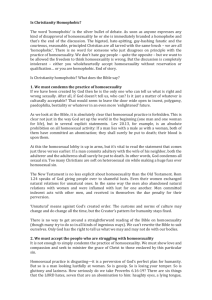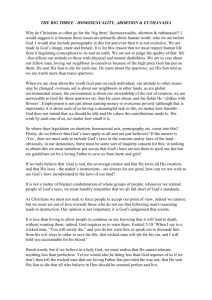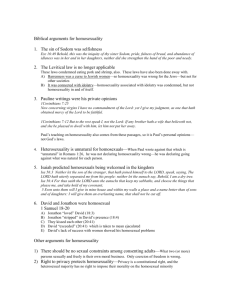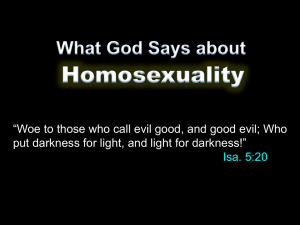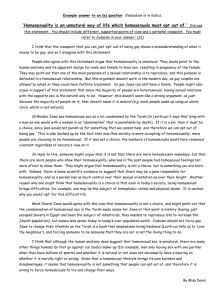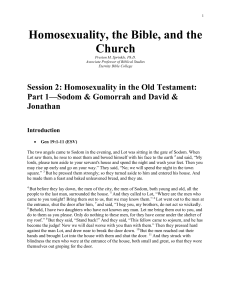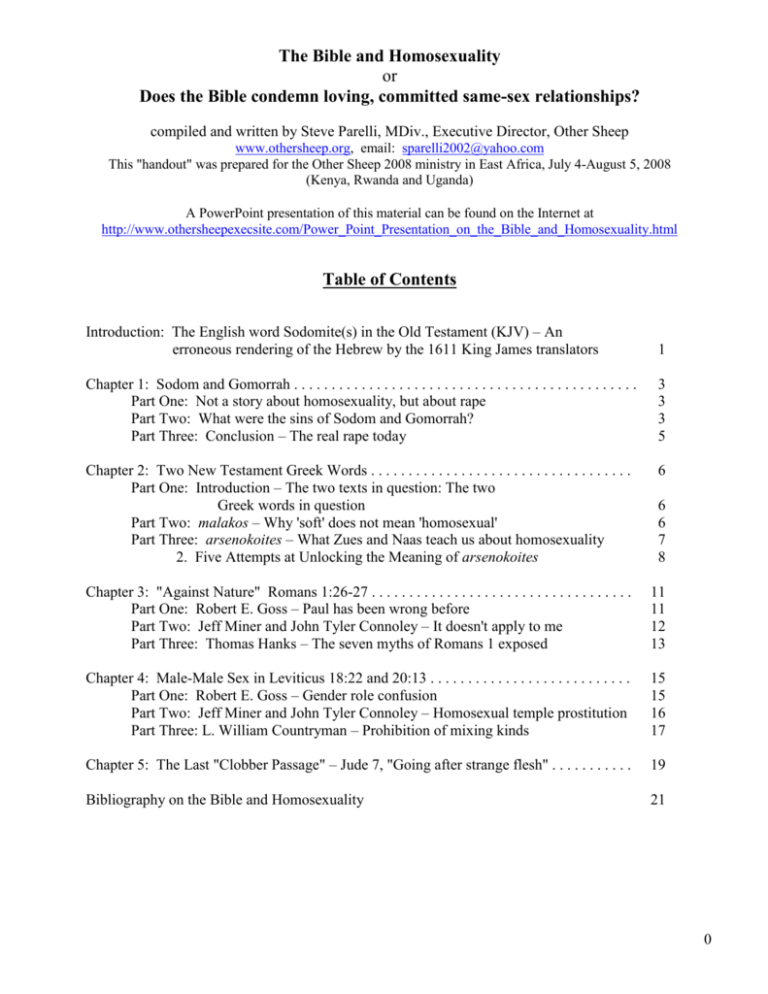
The Bible and Homosexuality
or
Does the Bible condemn loving, committed same-sex relationships?
compiled and written by Steve Parelli, MDiv., Executive Director, Other Sheep
www.othersheep.org, email: sparelli2002@yahoo.com
This "handout" was prepared for the Other Sheep 2008 ministry in East Africa, July 4-August 5, 2008
(Kenya, Rwanda and Uganda)
A PowerPoint presentation of this material can be found on the Internet at
http://www.othersheepexecsite.com/Power_Point_Presentation_on_the_Bible_and_Homosexuality.html
Table of Contents
Introduction: The English word Sodomite(s) in the Old Testament (KJV) – An
erroneous rendering of the Hebrew by the 1611 King James translators
1
Chapter 1: Sodom and Gomorrah . . . . . . . . . . . . . . . . . . . . . . . . . . . . . . . . . . . . . . . . . . . . . .
Part One: Not a story about homosexuality, but about rape
Part Two: What were the sins of Sodom and Gomorrah?
Part Three: Conclusion – The real rape today
3
3
3
5
Chapter 2: Two New Testament Greek Words . . . . . . . . . . . . . . . . . . . . . . . . . . . . . . . . . . .
Part One: Introduction – The two texts in question: The two
Greek words in question
Part Two: malakos – Why 'soft' does not mean 'homosexual'
Part Three: arsenokoites – What Zues and Naas teach us about homosexuality
2. Five Attempts at Unlocking the Meaning of arsenokoites
6
Chapter 3: "Against Nature" Romans 1:26-27 . . . . . . . . . . . . . . . . . . . . . . . . . . . . . . . . . . .
Part One: Robert E. Goss – Paul has been wrong before
Part Two: Jeff Miner and John Tyler Connoley – It doesn't apply to me
Part Three: Thomas Hanks – The seven myths of Romans 1 exposed
11
11
12
13
Chapter 4: Male-Male Sex in Leviticus 18:22 and 20:13 . . . . . . . . . . . . . . . . . . . . . . . . . . .
Part One: Robert E. Goss – Gender role confusion
Part Two: Jeff Miner and John Tyler Connoley – Homosexual temple prostitution
Part Three: L. William Countryman – Prohibition of mixing kinds
15
15
16
17
Chapter 5: The Last "Clobber Passage" – Jude 7, "Going after strange flesh" . . . . . . . . . . .
19
Bibliography on the Bible and Homosexuality
21
6
6
7
8
0
The Bible and Homosexuality
or
Does the Bible condemn loving, committed same-sex relationships?
------------------------------------In Uganda, in 1999, news stories reported "an alledged gay wedding in Kampala. [President Yoweri]
Museveni again spoke out strongly, calling for the police to find, arrest and jail homosexuals. The
Anglican archbishop of Uganda proclaimed his full support for Museveni's antigay position.
--Miranda K. Hassett, Anglican Communion in Crisis, p.85
And the remnant of the sodomites, which remained in the days of his father Asa, he took out of the land.
-- I Kings 22:46 (KJV)
-------------------------------------
Introduction: The English word Sodomite(s) in the Old Testament (KJV)
– an erroneous rendering of the Hebrew by the 1611 King James translators
1. The English word "Sodomite(s)" is used 5 times in the King James version of the Old Testament,
but NOT ONCE in the 1973 New International Version of the Old Testament.
THE KJV :
Deuteronomy 23:17
THE NIV :
There shall be no whore of the daughters
of Israel, nor a sodomite of the sons of Israel.
THE KJV :
No Israelite man or woman is to become a shrine
prostitute.
I Kings 14:24
THE NIV :
And there were also sodomites in the land:
and they did according to all the abominations of
the nations which the LORD cast out before the
children ofIsrael.
THE KJV :
There were even male shrine prostitutes in
the land; the people engaged in all the detestable
practices of the nations the LORD had driven out
before the
Israelites.
I Kings 15:12
THE NIV :
And he took away the sodomites out of the
land, and removed all the idols that his fathers had
made.
No Israelite man or woman is to become a shrine
prostitute.
Compiled and written by Steve Parelli, MDiv., Executive Director, Other Sheep, www.othersheep.org
1
I Kings 22:46
THE NIV :
THE KJV :
And the remnant of the sodomites, which
remained in the days of his father Asa, he took out
of the land.
He rid the land of the rest of the male
shrine prostitutes who remained there even after
the reign of his father Asa.
II Kings 23:7
THE NIV :
THE KJV :
And he brake down the houses of the
sodomites, that were by the house of the LORD,
where the women wove hangings for the grove.
He also tore down the quarters of the male
shrine prostitutes, which were in the temple of the
LORD and where women did weaving for Asherah
2. Why the discrepancy between the two translation? The answer, of course, is to be found in a
closer look at the Hebrew text. The Hebrew word kadesh in Deut. 23:17 is the same Hebrew word
used in the other four verses. Kadesh does not mean Sodomite, it refers to the "priest-prostitutes of
the Canaanite fertility cults" (Ralph Blair).
THE KJV :
Deuteronomy 23:17
KJV
HEBREW
There shall be no whore of the daughters
of Israel, nor a sodomite of the sons of
Israel.
What is the Hebrew word for Sodom?
whore
sodmite
קדשהkedeshah (fem.) Female Cult Prostitute
קדשkadesh (masc.) Male Cult Prostitute
– סדםSodom; (contrast kedesh – Cult Prostitute)
there is no relationship between this word (Sodom) and
the above word for Cult Prostitute -- קדש.
"The Hebrew words here (kedeshah and kadesh) are references to the "holy" female and eunuch
priest-prostitutes of the Canaanite fertility cults, of which Israel was to have no part." -Ralph
Blair.
Most English Bible Versions Today translate kadesh in Deuteronomy 23:7 as “shrine prostitute” or
“cult prostitute” or “temple prostitute”
Compiled and written by Steve Parelli, MDiv., Executive Director, Other Sheep, www.othersheep.org
2
The Bible and Homosexuality
or
Does the Bible condemn loving, committed same-sex relationships?
---------------------------------------------James Solheim, in his account of Lambeth 1998, reports Bishop Chukwuma's words to Kirker: "God did
not create you as a homosexual. That is our stand. That is why your church is dying in Europe – because
it is condoning immorality. Your are killing the church. This is the voice of God talking." Anglican
Communion in Crisis, M. K. Hassett, p72
.
-----------------------------------------------
Chapter 1: Sodom and Gomorrah:
In Three Parts
Not a Story about Homosexuality, but about Rape
What were The Sins of Sodom and Gomorrah?
Conclustion: The Real Rape Today
Part One: Not a Story about Homosexuality, but about Rape
The Text: Genesis:19:4-5
"…the men of the city, even the men of Sodom compassed . . .
"…Where are the men . . . bring them out unto us, that we may know them."
1. Ex-gay authors Bob Davies and Lori Rentzel comment on Gen. 19:4-5 in their 1993 Coming Out
of Homosexuality: New Freedom for Men & Women, p184:
"Pro-gay theologians are correct in saying that this passage does not provide a strong
argument against prohibiting all homosexual acts."
2. Loren L. Johns on Genesis 19
"To use Genesis 19 to condemn homosexuality makes as much sense as using II Samuel 13
(David and Bethsheba) to condemn heterosexuality.
"Genesis 19 – gang rape, possessive lust, and sexual abuse – cannot be construed as
condemning loving, committed homosexual relatioships.
"That Sodom has become synonymous with certain homosexual acts does not pertain to the
ethical issue of the propriety of loving, committed homosexual relationships.
Part Two: What were the Sins of Sodom and Gomorrah (Robert E. Goss)
The Text: Genesis 19:24
"Then the Lord rained upon Sodom and upon Gomorrah brimstone and fire . . . "
Compiled and written by Steve Parelli, MDiv., Executive Director, Other Sheep, www.othersheep.org
3
1. Violence: Male Rape
"Genesis 19 has nothing to do with same-sex sexuality; it has to do, rather, with male rape."
Robert E. Goss, Queering Christ
"The messengers are foreigners within the city, and the men of Sodom surround the house
and insist that 'we might know them' . . . a euphemism for sexual intercourse [which] needs
to be translated and contextualized in the sexual codes of the penetrator and the penetrated
in the ancient world. A more abpt colloquial translation would be to 'womanize, make into
a woman.' In the context, it suggests 'penetrating a male like a woman,' or anal
intercourse." Robert E. Goss, Queering Christ
"Ancient Near Eastern societies subjected those they had conquered, enemies, stangers, and
trespassers to phallic anal penetration to indicate their subordinate status." Robert E. Goss,
Queering Christ
2. Inhospitality: Abraham's hospitality (Gen 18) is contrasted with the hostility of Sodom (Gen. 19)
Hospitality is part of the cultural code and the editor's theological motif operative in
Genesis 18-19. … Robert E. Goss, Queering Christ
The editor contrasts the rural, pastoral welcoming of strangers [by Abraham, Gen. 18] with
the urban hostility [shown] them [by the residents of Sodom at Lot's door, Gen. 19] . . .
Robert E. Goss, Queering Christ
How the movie The Four Feathers illustrates the moral essence of hospitality in the Near East:
Harry Faversham (a lost Englishman, stranded in a desert, to an African at time of
war in the African's own country):
"Why are you protecting me?"
Abou Fatma: (The African to the lost Englishman, his enemy in time of war):
"God put you in my way. I have no choice"
OBSERVATION: This is the desert law of hospitality: "God put you in my way.
I have no choice but to protect you."
How Jesus' words indicate "inhospitality" as the sin of Sodom:
"When Jesus says that it will be more tolerable for Sodom than for those not
hearing God's messengers, he has in mind not the Sodomites' sexual practices but
their inhospitality." Roebert E. Goss, Queering Christ
Luke 10:10-12: "But into whatsoever city ye enter, and they receive you not . . . I
say unto you, that it shall be more tolerable in that day for Sodom, than for that
city."
Support from the Wisdom of Solomon
"And punishments came upon the sinners . . . Insomuch as they used a more hard
and hateful behavior toward strangers. For the Sodomites did not receive those,
whom they knew not when they came . . ." Wisdom of Solomon 19:13-14
Compiled and written by Steve Parelli, MDiv., Executive Director, Other Sheep, www.othersheep.org
4
3. Social Oppression: "The patriarchal violence to male strangers and to the daughters, 'the other'
inscribed within the biblical text." Robert E. Goss, Queering Christ
[T]he patriarchal gender code … privileges males over females. That code requires that
Lot protect male honor over female honor. In other words, it is better to shame a woman
than a man."
"So Lot offers the sexual capital of his household, his virgin daughters, in exchange for
preserving the honor of the strangers. The mob rape would dishonor not only the
messengers but also Lot, his household, all his clan, and all those people associated with
him." He must provide protection to the strangers -- the law of the desert, and will do so at
the expense of his own daughters. Robert E. Goss, Queering Christ
Part Three: The Conclusion – The Real Rape Today
The Text: Ezekiel 16:49
"Behold, this was the iniquity of thy sister Sodom: pride, fullness of bread, and abundance
of idleness was in her and in her daughters, neither did she strengthen the hand of the poor
and needy."
1. Injustice: to treat one another without a sense of justice, without a sense of what is right; this is
the sin of Sodom: Violence, Inhospitality, and Social oppression. These are all ways in which we
"rape" one another.
2. Ironically, ". . . The real act of sodomy [today] is the particular application of the [Sodomy] story
to [LGBT people] . . . [What we today is] the translation of textual violence [(to so wrongly
interpret Gen. 19)] into social violence [(and then to use Gen. 19 against a people group, a sexual
minority, to violate their spirit and their beings)]." This is the real rape, today. Robert Goss,
Queering Christ
Compiled and written by Steve Parelli, MDiv., Executive Director, Other Sheep, www.othersheep.org
5
The Bible and Homosexuality
or
Does the Bible condemn loving, committed same-sex relationships?
------------------------------------Lambeth 1998 had accomplished what it would be known for around the world and through the years: for
"rejecting homosexual practice as incompatible with Scripture" by a landslide vote, to the delight of many
and the horror and grief of many others." Anglican Communion in Crisis, M. K. Hassett, p79.
-------------------------------------
Chapter 2: Two New Testament Greek Words:
In Three Parts
Introduction – The Two Texts in Question: The Two Greek Words in Question
malakos – Why 'soft does not mean 'homosexual'
arsenokoites – What Zues and Naas teach us about homosexuality
Part One: Introduction – The Two Texts in Question: The Two Greek Words in Question
1. I Corinthians 6:9-10 KJV
Know ye not that the unrighteous shall not inherit the kingdom of God? Be not deceived:
neither fornicators, nor idolaters, nor adulterers, nor effeminate [malakoi], nor abusers of
themselves with mankind [arsenokoitai], (10) Nor thieves, nor covetous nor, drunkards,
nor revilers, nor extorioners, shall inherit the kingdom of God.
2. I Timothy 1:10 KJV
"them that defile themselves with mankind" [arsenokoitai]
3. The Two Greek Words in Question:
i. malakoi (plural form), makakos (singular form) I Cor. 6:9
ii. arsenokoitai (plural form), arsenokoites (singular form) I Cor 6:9 & I Tim. 1:10
Part Two: malakos – Why 'soft' does not mean 'homosexual'
(Malakos appears only in I Cor. 6:9 in the New Testament)
1. How malakos is rendered in I Cor. 6:9 by various translations of the Bible
Date
1611
1901
1971
1982
1984
1984
1987
Bible
King James Version
American Standard Version
The Living Bible (Paraphrase)
New King James Version
New International Version (NIV)
New International Version UK
Amplified Bible
translation of malakos
effeminate
effeminate
homosexuals (both Greek words in I Cor. 6:9)
homosexuals (Footnote: "That is, catamites")
male prostitutes
male prostitutes
those who participate in homosexuality (both Greek
words in I Cor. 6:9)
1989 New Revised Standard Version
(NRSV)
male prostitutes
Compiled and written by Steve Parelli, MDiv., Executive Director, Other Sheep, www.othersheep.org
6
1995 Contemporary English Version
2001 English Standard Version
pervert
men who practice homosexuality (both Greek words
in I Cor. 6:9; with this footnote: "The two Greek terms
translated by this phrase refer to the passive and active
partners in consensual homosexual acts."
2001 Today's New International Version
2002 The Message
male prostitutes
those who use and abuse each other/sex
2. Malakos, in this context of a list of sins, signifies a moral weakness or male prostitution.
malakos means soft as seen in Matt. 11:8
i. Matt. 11:8 But what went ye out for to see? A man clothed in SOFT (malakos)
raiment? Behold, they that wear SOFT (malakos) clothing are in king's houses.
malakos, in reference to individual men (who are SOFT) can refer to moral weakness
The Children Are Free by Jeff Miner and John Tyler Connoley, pages 16-18
i. Fearful – a lack of courage; more interested in pleasure than in duty
ii. Vain – preoccupied with making themselves more attractive, "whether they were
trying to attract men or women"
iii. Self-indulgent – "Laziness, degeneracy, decadence; expensive things, dressing well,
over eating" – Hence the use of the word "effeminate" (which is intolerable
misogynistic thinking)
malakos, in this context of "sexual sins," most likely refers to male prostitutes
The Children Are Free by Jeff Miner and John Tyler Connoley, pages 16-18
i. Recent studies suggest this rendering
ii. Rendered "male prostitutes" in the NIV and NRSV (widely used modern English
translations; see shaded rows in above table)
iii. "Soft" = the receptive partner in intercourse ("women like")
iv. Context: Paul is listing "sexual sins," hence perhaps "male prostitutes"
Part Three: arsenokoites – What Zues and Naas teach us about homosexuality
(Arsenokoites appears only in I Cor. 6:9 and again in I Tim. 1:10 in the New Testament)
1. How arsenokoites is rendered in I Cor. 6:9 & I Tim. 1:10 by various translations of the Bible
Date
1960, 1995
1973, 1984
1973, 1984
1989
Version
NASB New American
Standard Bible
NIV New International
Version
NIVUK New International
Version – UK
NRSV New Revised
Standrd Version
I Cor. 6:9 arsenokoites
homosexuals
homosexual offenders
I Tim. 1:10 arsenokoites
homosexuals (Footnote: Lev.
18:22)
perverts
homosexual offenders
perverts
sodomites
sodmites
Compiled and written by Steve Parelli, MDiv., Executive Director, Other Sheep, www.othersheep.org
7
1989, 1995
1993, 2002
2001, 2005
NRSV (Anglican Edistion)
The New Revised Standard
Version
MSG The Message
sodomites
sodomites
use and abuse sex
TNIV Today's New
International Version
practicing homosexuals
riding roughshod over God,
life, sex
those practicing
homosexuality
". . . this shift in translation [to homosexuality] . . . [was] prompted . . . by shifts in modern
sexual ideology." - Sex and the Single Savior, by Dale Martin, p 39, his discussion on
arsenokoites.
2. Five Attempts at Unlocking the Meaning of arsenokoites
The Children Are Free by Jeff Miner and John Tyler Connoley, pages 16-21, 26
"Because of its rarity, we can only guess at what the word means. The following leaves us with no
final ansers:"
a. It is a compound word – But this does not unlock the meaning
arseno – koitos = male – bed
That it "obviously" means homosexual "difies common sense and linguistic evidence"
"The definition of a compound word is not 'obviously' known by the definition of its
root word componets"
i. pyromania = obsession with fire [pyro = fire, object of mania]
ii. nymphomania = obsession with men [nympho = bride, not "men", adjective to
mania]
iii. ladykiller = (1) a lady who kills? or (2) someone who kills a lady? or (3) "wolf"
or "Don Juan" – This third meaning is the meaning and is "largely unrelated" to
the two compounds.
b. Its usage before Paul does not unlock the meaning – There are no known usages before
Paul
I Corinthians 6 and I Timothy 1 “may be the first examples we have of this word being
used in the literature of the time.”
The Only Unlikely Possible Exception
o Sibylline Oracles, a collection of writings over a period of many centuries,
may or may not predate. “The dating of the particular oracle in which this
word appears is uncertain.”
c. Its usage after Paul does not unlock the meaning (AD 100 – AD 700)
"Scholars have identified only 73 times this term is used in the six centuries after Paul"
i. Go to the following website for all the instances and derivatives:
http://www.jeramyt.org/gay/arsenok.htm
ii. "In virtually every instance the term appears in a list of sins (like Paul's) without
any story line or other context to shed light on its meaning"
iii. "There are a few helpful exceptions:"
a) Zeus and Ganymede
"The term is used by a Greek author when cataloguing the
sins of the Greek gods"
Compiled and written by Steve Parelli, MDiv., Executive Director, Other Sheep, www.othersheep.org
8
The Greek author: Arisites, Apology 13, Fragments 12.9 –
13.5.4
"In this context the term is probably intended to refer to the
time Zeus abducted and raped a young boy, Ganymede."
In the form of an eagle, Zeus came down and seized the
young beautiful boy Ganymede and carried him off by force
to make him his lover and cupbearer.
b) Naas and Adam
According to Greek legend, Naas (the name given to the
snake in the garden once it became a Satanic gibure) commits
"adultery" with Adam.
Source: Hippolytus' Refutatio, chapter 5; Cf. J. Townsley
According to Hippolytus, it is by this act of "adultery" that
arsenokoites enters into the world. Hippolytus relates Naas
and Adam back to Zeus and Ganymede.
Summery of Zeus and Ganymede, of Naas and Adam
"In neither of these instances do we find a mutually consenting,
equal relationship – we find a powerful aggressor subjugating the
weak. This human rights violation (in modern terms) gives
arsenokoites the meaning that makes sense in the few contexts/lists
that we have." Jeramy Townsley, Search for God's Heart and Truth
Therefore, arsenokoites does not condemn us in our mutually
consenting same-sex relationships.
d. Its context: It is set in "lists" which may give us a clue
"In I Cor. 6:9, we find apsenokoitai between malakoi (which may refere to male
prostitutes and "thieves." Therefore, arsenokoitai comes between two lists of sins: the
first list is a list of Sex Sins and the second list is a list of Economic Sins.
In I Tim 1:10, arsenokoitai also comes between a list of Sex Sins and a list of
Economic Sins, between "fornication" which ends the first list and "slave traders"
which begins the second list.
From its place in the two New Testament lists we can infer that arsenokoitai "describes
a male who aggressively takes sexual advantage of another male. This is consistent
with the meaning found in the story of Zeus and Ganymede, and Naas and Adam."
e. Its remote possible link to the LXX (The Hebrew Old Testament translated into Greek by
"70" translators, hence "the LXX")
In the LXX in Lev. 20:13, the two Greek words of our compound word αρσενο/κοιται
appear side by side as two separate words.
i. Lev. 20:13 LXX και ος αν κοιμηθη μετα αρσενος κοιτην γυναικος βδελυγμα
εποιησαν αμφοτεροι θανατουσθωσαν ενοχοι εισιν
o Lev. 20:13 “If a man also lie with mankind, as he lieth with a woman, both
of them have committed an abomination; they shall surely be put to death;
their blood shall be upon them.” KJV
Compiled and written by Steve Parelli, MDiv., Executive Director, Other Sheep, www.othersheep.org
9
I Cor. 6:9 I Tim 1:10
arseno/koitais – dative case
LXX Lev. 20:13
αρσενο/κοιται(σ)
αρσενος
κοιτην
“Lev. 20:13 was written in the context of cultic sexual practices, including temple
prostitution. If Paul derived the term arsenokoitai from Lev. 20:13 (and that’s a big if),
it would follow that . . . he was intending to prohibit cultic sexual practices.”
Compiled and written by Steve Parelli, MDiv., Executive Director, Other Sheep, www.othersheep.org
10
The Bible and Homosexuality
or
Does the Bible condemn loving, committed same-sex relationships?
------------------------------------For many practicing Christians, the … inability to compromise … appl[ies] to gay marriage. I am not
willing to have the state deny American citizens … equivalent rights … because the people they love are
of the same sex – nor am I willing to accept a reading of the Bible that considers an obscure line in
Romans [‘against nature’] to be more defining of Christianity than the Sermon on the Mount.” (Obama,
2006, The Audacity of Hope, p222)
-------------------------------------
Chapter 3: "Against Nature" Romans 1:26-27
In Three Parts
Robert E. Goss: Paul Has Been Wrong Before
Jeff Miner and John Tyler Connoley: It Doesn't Apply to Me
Thomas Hanks: The Seven Myths of Romans chapter 1 Exposed
Part One: Robert E. Goss: Paul Has Been Wrong Before
1. How Robert Goss interprets Romans 1:26-27
What is Paul Saying? Ans.: Idolatry Leads to "Disordered Sexuality"
i. In Paul's thinking (Romans 1), the exchange of the Creator for a creature leads to …
men … giving up natural relations with women (page 200).
ii. For Paul, Gentiles have exchanged God for created things, resulting in disordered
sexuality (page 200).
Why is Paul Discussing This? Ans.: Paul's Immediate Context – An 'Entrapment' for
Judgmental Jews (Romans2)
i. Romans 1:26 & 27 ("against nature") form part of Paul's larger argument on
idolatry (Romans 1) and functions as a prelude for arguing against judgmental
Jewish critics in Romans 2 (page 200)
2. The following authors, according to Robert Goss, purpose to "rehabilitate Paul" for the Queer
community):
John Boswell argues that heterosexually oriented people engaged in homosexual acts
(thus it was "against nature" for them as heterosexuals). Critiques site his use of moern
sexual-identity template as an anachronistic application to ancient sexuality (page 200).
James Miller argues that "against nature" is a reference to unnatural heterosexual oral or
anal intercourse
Compiled and written by Steve Parelli, MDiv., Executive Director, Other Sheep, www.othersheep.org
11
Tom Hanks agrees with Miller that "against nature" refers to women engaged in anal sex
with men to avoid procreation
Robin Scroggs sees "against nature" as a reference to older men with youths based on the
existing cultural pederasty in the Greco-Roman world
L. William Countryman argues that "against nature" is to be understood within the purity
codes of Judaism. The unclean homoerotic acts of the Gentile world are now insignificant
in Christ. Paul refers to these acts only rhetorically so he can later unpack Jewish
sinfulness (page 201.
Daniel Halminiak views "against nature" as "beyond nature." The acts here are
heterosexual nonprocreative sex acts: intercourse during menstruation, intercourse
standing up, and oral or anal sex. In context, Paul is rehetorically addressing Jewsish
superiority over Gentile impurity (page 201).
3. Goss agrees with Bernadette Broonten's view on "against nature"
She is not rehabilitating Paul (like the above authors) (page 201).
Her gender analysis undercuts the above male perspective (page 201)
Her view on "against nature:" Women exchanged the passive, subordinate sexual role for
an active autonomous role" (page 201).
i. Goss quotes Marti Nissinen: "It was woman's active sexual role that was regarded
as truly contrary to nature." Homoeroticism in the Anctien World, p108.
ii. Male-female sex roles (active-passive, penetrator and penetrated) were intertwined
with the cultural gender codes in the dominant Greco-Roman culture of the first
century C.D., page 201.
iii. Brooten comprehends "aginst nature" (Romans 1:26-27) in light of I Corinthians
11:2-16, where Paul describes a natural hierarchy of man over woman in which
hairstyle and headdress differentiate gender and are understood as natural (page
201)
iv. Goss quotes Marti Nissinen: "This hierarchical pattern was not invented by Paul but
belonged to his culture" (Eastern Mediterranean world). Gender role categories
were determined by anatomy and portrayed by conformity to estableished gender
roles. Homoeroticism in the Ancient World, p107.
4. Conclusion: Goss' view on Romans 1:26-27 ("against nature")
According to Paul (Romans 1), disordered sexuality resulted when the Gentiles exchanged
God for created things (idolatry), page 200. [See #1, above]
The issue at the heart of Romans 1:6-27 ("against nature") is
i. the rigid gender codes Paul grew up with as a Phrisaic Jew [See #3, above],
ii. and his own fears about his sexual drives, page 202.
These are Paul's personal opinions woven into his pastoral letter to the Romans. Many
Christians no longer condone his acceptance of slavery nor his statements about women,
page 202.
Part Two: Jeff Miner and John Tyler Connoley: It Doesn't Apply to Me
1. Paul's logical progession in Romans 1:21-31: Paul is talking about people who . . .
Refused to acknowledge God (v.21), then . . .
Compiled and written by Steve Parelli, MDiv., Executive Director, Other Sheep, www.othersheep.org
12
Began to worship idols (v.23), then . . .
Prefered earthly pursuits over spiritual (v.25), then . . .
Gave up their innate passion for the opposite sex in search of unbounded pleasure (v. 2627), and . . .
Lived lives full of covetousness, malice, envy, etc. and hatred of God (v.29-31), page 14.
2. Paul is addressing a different set of facts: "The easiest passage to interpret"
Gay Relationship Model in the 21st Century
Not part of idol worship
Naturally homosexual
Accepts God
Accepts their sexual orientation
Sex within their orientation
Sex with committed partners
Paul's Model in Romans 1:1-31
Associated with idol worship
Naturally heterosexual
Rejected God
Rejected their sexual orientation
Sex outside of their orientation
Sex with temple prostitutes
Part Three: Thomas Hanks: The Seven Myths of Romans 1 Exposed
Myth #1 & 2 Exposed:
(a) Myth
Paul condemns all homosexuals
(a) Myth
Paul condemns all
homosexual acts
(b) Fact
Paul has no concept of sexual orientation
(b) Fact
Paul only condemns lustful, self-serving passions. He does not
condemn loving same-sex relationships
(c) Did you know?
The term "heterosexual" was coined only after the term "homosexual" was coined. The word
"homosexuall," coined by the Hungarian writer Karoly (or Karl) Benkert in 1869, entered the English
vocabulary when Krafft-Ebbing's Psychopathis Sexualis was translated into English in the 1890s.
Myth #3 Exposed:
(a) Myth
Paul condemns
lesbians
(b) Fact
Paul, in Romans 1:26, is not speaking of women who changed sex partners
(from male to female), but he is speaking of women who changed sexual
practices (with men); that is instead of coitus (with men), they practiced anal sex
and oral sex (with men).
(c) Did you know?
John Chrysostom, ca. 400 AD, was the first to misinterpret Romans 1:26 as a reference to lesbians
Compiled and written by Steve Parelli, MDiv., Executive Director, Other Sheep, www.othersheep.org
13
Myth #4 Exposed:
(a) Myth
Paul condemns
homoerotic
acts as sin
(b) Fact
Paul places these acts under the cultural category of "uncleanness" which
describes material things as "out of their appropriate palace." Semen deposited
"out of place" left the individual "unclean."
(c) Did you know?
An unclean person was disqualified for participation in Old Testament worship until declared clean.
The apostle Peter said: "I have never eaten anything that is common or unclea."
Myth #5 Exposed:
(a) Myth
Paul demonstrates
that homosexuality
is the worst sin.
(b) Fact
What Paul describes is the divine punishment of idolatrous people whom
God has abandoned. Further, in verse 31, he describes them as "without
mercy" for the poor, weak, and oppressed.
(c) Did you know?
Jesus places a high premium on love and mercy shown to the poor, weak and oppressed. Matt. 25:31-46.
Myth #6 Exposed:
(a) Myth
Paul condemns all
homoerotic acts for
being "against
nature."
(b) Fact
Not all homoerotic acts are against nature. That which is "natural" for
some (a homosexual having same-sex sex) is "against nature" for others (a
heterosexual having same-sex sex).
(c) Did you know?
Homoerotic acts are common in more than 450 animal species.
Compiled and written by Steve Parelli, MDiv., Executive Director, Other Sheep, www.othersheep.org
14
The Bible and Homosexuality
or
Does the Bible condemn loving, committed same-sex relationships?
------------------------------------"When Christians ignore most of the Holiness Code and regard its precepts as irrelevant . . . and yet cite
the Levitical prohibitions against homosexuality . . . one is led to wonder what is behind the adoption of
the prohibition and the casting away of others." -Gomes:1996, p154-155.
-------------------------------------
Chapter 4: Male-Male Sex Leviticus
18:22 and 20:13
In Three Parts
Robert E. Goss: Gender Role Confusion
Jeff Miner and John Tyler Connoley: Homosexual Temple Prostitution
L. William Countryman: Prohibition of Mixing Kinds
Leviticus 18:22 KJV--
Thou shalt not lie with mankind, as with womankind: it is abomination.
Introductory Remarks
This commandment applies to us today if the same conditions exist today that existed when the
law was first given. To illustrate this principal . . .
In order for a lawyer to argue his position by referring to a decision handed down
by the courts on a former case, two things must hold true:
1. The rule established by the former case is limited to the facts of that case.
2. The facts of the current case must be similar enough to the facts of the
former case in order for the rule established by the former case to be
applied to the current case.
Therefore, the facts of both cases must be carefully examined to determine
whether they are similar enough for the rule to apply to any following case.
This illustration is taken from The Children Are Free,
Miner & Connoley, p. 8
Part One: Robert E. Goss: Gender Role Confusion
1. How to translate Lev. 18:22? (Queering Christ, Goss, p. 189-190)
"And with a male you shall not lie the lyings of a woman, it is abomination."
ל ֹא ִתשכב ִמשכב ִאשָּׁ ה
1. "ehl tonuu ahs uoy" ל ֹא ִתשכב ִמשכב ִאשָּׁ ה
Compiled and written by Steve Parelli, MDiv., Executive Director, Other Sheep, www.othersheep.org
15
2.
"soy ueoaft hg n lhena"
ל ֹא ִתשכב ִמשכב ִאשָּׁ ה
"The lyings of a woman" means male-to-male anal intercourse. This is a reference
specifically to vaginal intercourse. Male-to-male anal penetration was seen as analogous
to vaginal penetration on some level.
-Saul Olvan, Brown University biblical scholar
2. Therefore, what Lev. 18:22 did NOT restrict: male-with-male masturbation or male-with-male
oral sex, or intracrural sex between men or any other form of male-to-male sex (other than anal
intercourse); female-to-female sex.
3. A Talmudic interpretation of the male-male texts of the Holiness Code (Lev. 18 and 20).
Note: Though this commentary is historically much later, it is consistent with the gender
codes of the earlier period (Queering Christ, Goss, p 191).
It is sex-role reversal, or gender deviance, that is problematized here. There was something
pathological and depraved . . . in . . . an adult male allowing his male body to be used as if it were
the body of a person of penetrable status. . . . [The] penetration of a male constituted a consignment
of him to the class of females . . . a degradation of status; this constituted a sort of mixing of kinds, a
general taboo occurrence in Hebrew culture.
Observe: the issue here is not a moral question over same-sex sexuality; but the issue is
over gender roles, sexism, even misogyny.
Part Two: Jeff Miner and John Tyler Connoley: Homosexual Temple Prostitution
1. The context of Leviticus 18 and 20
The text tells us three times that "the rules set forth in chapters 18 and 20 are meant to
prevent the Israelites from doing what the Egyptians and Canaanites did. The children Are
Free, Jeff Minor and John Tylor Connoley, p.10
"After the doings of the land of Egypt, wherein ye dwelt, shall y e not do: and after
the doings of the land of Canaan, whither I bring you, shall ye not do." Lev. 18:3.
Cf. Lev. 18:24; Lev. 20:23.
It cannot be emphasized enough that Lev. 19 and 20 specifically say they were
written to address pagan religious practices, and that both chapters include long
lists of sexual practices common in these Canaanite and Egyptian cultic rituals.
The Children Are Free, p. 11.
2. If we can determine what type of homosexual behavior was common among the Canaanites and
Egyptians, we will better understand what these verses meant to prohibit. The Children Are Free,
p.10.
Many Canaanites and Egyptians worshipped a goddess of love and fertility called Astarte
or Ishtar. Ibid, p10
Every kind of sexual practice imaginable was performed at these rituals, including
homosexual sex. Ibid, p11
Compiled and written by Steve Parelli, MDiv., Executive Director, Other Sheep, www.othersheep.org
16
Sexual intercourse was considered especially effective for gaining the goddess's favor,
because the male worshiper was offering his greatest possession, semen – the essence of
life. Ibid, p11
3. Compare Daniel Helminiak with Miner & Connoley
The Canaanite religion included fertility rites. During these rituals whole families and
groups of families all might have sex with one another. What the Bible Really Says About
Homosexuality, Daniel Helminiak, p.46.
Leviticus condemned homogenital sex as a religious crime of idolatry, not
as a sexual offense. Ibid., p45.
The argument in Leviticus is religious, not ethical or moral. No thought
is given to whether the sex in itself is right or wrong. All concern is for
keeping Jewish identity strong. Ibid, p47.
4. Conclusion:
Leviticus 18 and 20 are clearly directed at homosexual temple prostitution,
and that is how they should be applied. The Children Are Free, p. 12.
Leviticus 18:22 and 20:13 are the only direct references to male homoeroticism in the
Hebrew Scriptures. Orthodox Jews and fundamentalist Christians take the verses as a
blanket condemnation of all homosexual practices. Queering Christ, Robert Goss, p. 189.
Part Three: L.William Countryman: Prohibition of Mixing Kinds
1. Torah was the basic law of Israel in all respects, no distinction was made between religious and
nonreligious elements.
To be a Jew did not mean to primarily confess a certain faith, but rather to belong to a certain
people. One was obliged to participate fully. The alternative was to become a nonperson.
2. The purity laws of Israel were one of the principal forces that kept Israel separate from the nations.
a. The two most substantial collections of purity law are found in Leviticus. The first, Lev.
11-16; the second, Lev. 17-26.
b. The inner rationale of the purity system (two principals):
i. Principal 1: God’s holiness means wholeness and completeness, not only in God,
but in God’s creation.
1. Lev. 13:13 Then the priest shall consider: and, behold, if the leprosy have
covered all his flesh, he shall pronounce him clean that hath the plague: it is
all turned white: he is clean.
a. The essence of the impurity occasioned by leprosy is not the disease
itself . . . But that the whole and complete human being ought to be
of a single hue.
ii. Principal 2: Prohibition of mixing ‘kinds,’ like mixing wool and linen
1. This is the reason for the condemnation of homosexual acts. No one
person must seek to combine mutually exclusive perfections (a male "taking
the place of the woman" in the sex-act, mixes two perfections – his male
body with his "female" actions)
Compiled and written by Steve Parelli, MDiv., Executive Director, Other Sheep, www.othersheep.org
17
a. The phrasing “the lyings of a woman” makes clear that a male who
fulfills the “female” role is a combination of kinds (male and female)
and therefore unclean like a cloth composed of both linen and wool.
b. The act that renders the “female” partner unclean is the joint
responsibility of both partners. Lev. 20:13.
The Extreme Christian Fundamentalist Alternative
Gay Christians who embrace their orientation become nonpersons. They are obliged to condemn
homosexuality (as the worst of sins) or to be separated from the family circle and the church
community as an outcast.
Compiled and written by Steve Parelli, MDiv., Executive Director, Other Sheep, www.othersheep.org
18
The Bible and Homosexuality
or
Does the Bible condemn loving, committed same-sex relationships?
---------------------------------------------To repeat a slogan I have often used in speaking to various audiences: "Texts don't mean. People mean
with texts." Thus much of my work has been an attempt to disabuse people of the myth of textual agency.
Sex and the Single Savior, Dale B. Martin, p1
.
-----------------------------------------------
Chapter 5: The Last "Clobber Passage:" Jude 7 – "Going After Strange
Flesh"
“Even as Sodom and Gomorrah, and the cities about them in like manner, giving themselves over to
fornication, and going after strange flesh, are set forth for an example, suffering the vengeance of eternal
fire.” KJV
Source: The Children Are Free by Jeff Miner and John Tyler Connoley, pages 6-7
Associations of Sodom with Homosexuality
o When we read this verse in [our modern world], having been raised in a culture that
despises gays, it is easy to assume that Jude’s reference to “going after strange flesh” must
mean homosexuality.
o However, well informed theologians will tell you this is not what Jude was talking about.
What was Jude Talking about? The women of Sodom had sex with angelic flesh
o At the Time of the Writing of the Book of Jude a first century “legend” held that in the
story of Genesis 6, angles (“sons of God”) had taken the daughters of women as wives.
According to first century legend:
• Angels married with women (Gen. 6)
• This final sin brought the flood – God’s judgment
• Some time later the sin was repeated when the women of
Sodom had sex with angelic flesh (Gen. 19)
• Some Jewish writers believed this was the sin which
sealed Sodom’s fate.
o For An Excellent Discussion of this first century legend: See Martti
Nissinen, Homoeroticism in the Biblical World, pages 91-93, in which he
discusses Jewish writings from 200 to 1 BC which associate the sin of the
people of Sodom with that of the people before the flood of Noah.
o Many Theologians, Including Many Conservatives, Interpret Jude 7 This
Way
Compiled and written by Steve Parelli, MDiv., Executive Director, Other Sheep, www.othersheep.org
19
•
•
•
•
•
•
JND. Kelly (Harper and Row)
Fred Craddock (John Knox Press)
Richard Bauckham (Word Books)
Michael Green (Inter-Varsity Press)
CEB. Cranfiel (SCM Press)
Richard Hays (Harper)
Compiled and written by Steve Parelli, MDiv., Executive Director, Other Sheep, www.othersheep.org
20
Bibliography on the Bible and Homosexuality
Bagemihl, Bruce, 1999, Biological Exuberance: Animal Homosexuality and Natural Diversity, New York,
NY: St. Martin's Press.
Bellis, Alice Ogden and Terry L. Hufford, 2002, Science, Scripture and Homosexuality, Cleveland, OH:
The Pilgrim Press.
Boswell, John, 1980, Christianity, Social Tolerance, and Homosexuality: Gay People in Western Europe
from the Beginning of the Christian era to the Fourteenth Century, Chicago: The University of Chicago
Press.
Boswell, John, 1995, The Marriage of Likeness: Same-sex Unions in Pre-Modern Europe, London,
England: Fontana Press.
Cantarella, Eva, 1992, Bisexuality in the Ancient World, trans. Cormac O Cuilleanain, New Haven,
Connecticut: Yale University.
Carden, Michael, 2004, Sodomy: A History of a Christian Biblical Myth, London: Equinox Publishing
Ldt.
Countryman, L. William, 1988, Dirt, Greed and Sex: Sexual Ethics in the New Testament and Their
Implications for Today, Philadelphia, PA: Fortress Press.
Bates, Stephen, 2004, A Church at War: Anglicans and Homosexuality, New York, NY: I.B.Tauris &
Co. Ltd.
Brown, Peter, 1988, The Body and Society: Men, Women, and Sexual Renunciation in Early Christianity,
New York, NY: Columbia University Press.
Davidson, Richard M., 2007, Flame of Yahweh: Sexuality in the Old Testament, Peabody, MA:
Hendrickson Publishers, Inc.
Fone, Byrne, 2000, Homophobia: A History, New York, NY: St. Martin's Press.
Greenburg, David F., 1988, The Construction of Homosexuality, Chicago, IL: The University of Chicago
Press.
Greenberg, Rabbi Steven, 2004, Wrestling with God & Men: Homosexuality in the Jewish Tradition,
Madison, WI: The University of Wisconsin Press.
Goldberg, Jonathan, 1994, Reclaiming Sodom, New York, NY: Routledge.
Gomes, Peter J., 1996, The Good Book: Reading the Bible with Mind and Heart, New York, NY: Avon
Books.
Compiled and written by Steve Parelli, MDiv., Executive Director, Other Sheep, www.othersheep.org
21
Goss, Robert E., 2002, Queering Christ: Beyond Jesus Acted Up, Cleveland, OH: The Pilgrim Press.
Guest, Deryn, Edited by, and Robert E Goss, Mona West, Thomas Bohache, 2006, The Queer Bible
Commentary, London: SCM Press.
Hassett, Miranda K., 2007, Anglican Communion in Crisis: How Episcopal Dissidents and Their African
Allies Are Reshaping Anglicanism, Princeton, NJ: Princeton University Press.
Helminiak, Daniel A., 1994, What the Bible Really Says About Homosexuality: Recent findings by top
scholars offer a radical new view, San Francisco, CA: Alamo Square Press.
Jennings, Theodore W., Jr., 2003, The Man Jesus Loved: Homoerotic Narratives from the New
Testament, Cleveland, Ohio, The Pilgrim Press.
Jennings, Theodore W., Jr., 2005, Jacob's Wound: Homoerotic Narrative in the Literature of Ancient
Israel, New York, New York: Continuum.
Jordon, Mark D., 1997, The Invention of Sodomy in Christian Theology, Chicago, IL: The University of
Chicago Press.
Johnson, William Stacy, 2006, A Time to Embrace: Same-Gender Relationships in Religion, Law, and
Politics, Grand Rapids, Michigan: Wm. B. Eerdmans Publishing Co.
Martin, Dale B., 2006, Sex and the Single Savior: Gender and Sexuality in Biblical Interpretation,
Louisville, KY: Westminster John Knox Press.
Miner, Jeff and John Tyler Connoley, 2002, The Children Are Free: Reexamining the Biblical Evidence
on Same-sex Relationships, Indianapolis, Indiana: Jesus Metropolitan Community Church.
Myers, David G. and Letha Dawson Scanzoni, 2005, What God Has Joined Together: The Christian Case
for Gay Marriage, New York, NY: HarperCollings.
Nissen, Martti, 1998, Homoeroticism in the Biblical World: A Historical Perspective, Minneapolis, MN:
Augsburg Fortress.
Roberts, Jack, 2006, Jesus, The Bible, and Homosexuality: Explode the Myths, Heal the Church,
Louisville, KY: Westminster John Knox Press.
Scroggs, Robin, 1983, The New Testament and Homosexuality: Contextual Background for
Contemporary Debate, Philadelphia, PA: Fortress Press.
Siler, Mahan, 2005, Exile or Embrace? Congregations Discerning Their Response to Lesbian and Gay
Christians, Cleveland, OH: The Pilgrim Press.
Silker, Jeffrey S., Editor, 1994, Homosexuality in the Church: Both Sides of the Debate, Louisville, KY:
Westminster John Knox Press.
Compiled and written by Steve Parelli, MDiv., Executive Director, Other Sheep, www.othersheep.org
22

